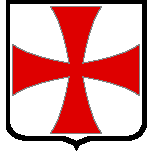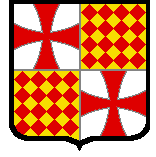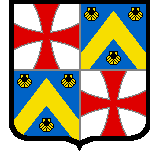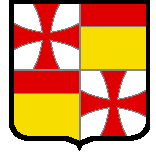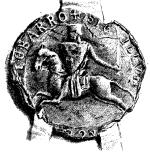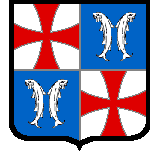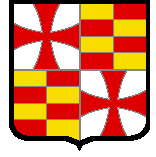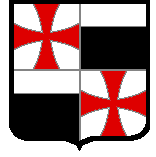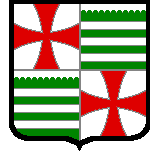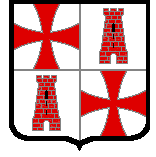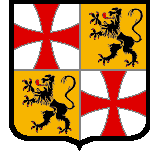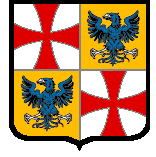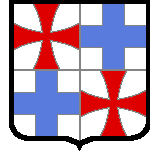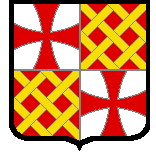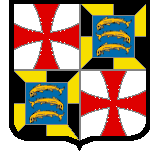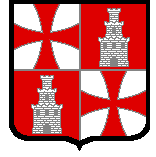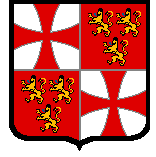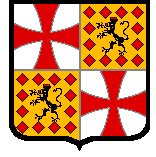 Renaud de Vichiers (1198??-1252) Renaud de Vichiers (1198??-1252)
Master of the Order from 1250 to 1252.
Renaud de Vichiers was born around 1198 in the familial domain of Vichiers, Champagne.
He was successively Preceptor of Saint-Jean d’Acre(1240), Master of France and finally Marshal when he was elected Master in May 1250. His appointment took place in the middle of Templar reinforcements which arrived just before the battle of Bahr al-Saghir.
Some days after this battle, Louis IX was captured by Mameluks. The captive was to be liberated upon the payment of a 200000 livres ransom. Lord of Joinville, the King’s chronicler, did all he could to gather the sum, but he fell 30000 livres short.
Joinville called on the Master of the Temple to grant him a loan to complete the ransom money.
Renaud de Vichiers, to the astonishment of the Frankish chiefs, refused to loan the money, giving as a pretext that the money present in the Temple Galley off Damiette did not belong the Temple but to a third party.
Nevertheless, Renaud de Vichiers notified Joinville that he would not try anything if he wanted to take the money by force. Joinville complied immediately. He entered the Galley of the Temple, took the 30000 livres and gave the complete ransom to Mameluks.
Some historians mention that the General Chapter of the Order judged the attitude of Renaud de Vichiers as scandalous. They go on to suggest that the General Chapter asked for and obtained the resignation of de Vichiers in 1252. Whether this was true or not, in 1252 Renaud de Vichiers did retire to a monastery where he stayed until his death in 1257.
Another version of history mentions that despite his attitude, de Vichiers accompanied King Louis IX to Saint-Jean d’Acre where he disembarked a short time after his liberation from Mameluks.
de Vichiers apparently then lead several raids to contain the Muslim hordes who were busy destroying the last Frankish possessions. In this version of history de Vichiers lead these raids until his death in 1257.
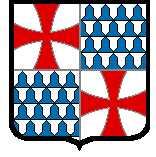
Previous Master : Guillaume de Sonnac - Next Master : Thomas Béraud
 Thomas Beraud (12??-1273) Thomas Beraud (12??-1273)
Master of the Order from 1252 (or 1257 according to different sources) to 1273.
Thomas Beraud (or Berard) is an enigmatic person within the Order because his career is a mystery to historians. Some say he became Master in 1252 when Renaud de Vichiers was forced to retire. Others say Beraud became Master in 1257 when de Vichiers died.
Regardless of which version of history is correct, it is known that when Beraud was elected he found an Order in decay. Their possessions in the Holy Land were reduced to a mere few some cities and fortresses. In addition the quarrels between the Templars and the Hospitallers were far from over.
If this were not enough, in 1257-1258 a civil war broke out between two important clans. On one side were the Templars and the Venetians, on the other side were the Hospitallers and Genoese merchants.
In 1260, yet another challenge arose when the Mameluk Baïbars murdered Outuz, the Sultan of Caïro. By taking his place Baïbars created the biggest scourge since Saladin.
In April 1263, Baïbars besieged Acre. He seized some districts outside the city, but because of resistance by the Templars and Hospitalers, he left after a few days of fighting.
At the beginning of 1264, the Templars and Hospitalers seized the stronghold of Lizon, between Caïffa and Jenin. In June, both the Orders organised a raid which devastated the region of Ascalon and resulted in the slaughter of a 300 strong mameluk military column.
In July it was the turn of the Egyptians to devastate villages between Cesaree and the fortress of Athlit.
In 1265, Baïbars began a devastating foray in Frankish territories. In March, he seized and destroyed the stronghold of Cesarea. On his way, he seized Caiffa and reduced the city to dust.
At the end of March, he tried to seize Chateau-Pelerin, the Templar fortress, but he failed because of the courage of the Templars defending the walls. Baîbars later tried to attack Arsûf, but the city was defended by 300 Hospitaler Knights who also strongly resisted. The attack by Baîbars lasted a month after which time the city eventually capitulated.
Baîbars promised to free the knights who defended the city, but he actually arrested them and put them in chains as soon as they left the walls.
In 1266, Baîbars returned. This time, he went to the fortress of Safed, held by the Templars. He began the attack on July 7th and immediately suffered huge losses. Baîbars was even forced to execute several of his generals who wanted to abandon the siege an fall back on easier prey.
Around July 25th, Baîbars managed to do overthrow the fortress. Again he promised that the Frankish garrison could retire safely to Acre. On hearing the promise the Templars left the fortress full of confidence. Baîbars encircled them and beheaded each and every man.
Some Chroniclers suggest that Thomas Beraud was a member of the Safed garrison and that he escaped because he denied Christianity. Although this suggestion lacks credibility it nevertheless furthered the accusations by Philippe IV and Grand Inquisitor Nogaret in 1307.
Due to the fall of all these strongholds and fortresses, Thomas Beraud and the Master of the Hospitalers sent a despairing message to the Pope. This message prompted the Pope to preach for the Eighth Crusade.
Only the Kings of France and Aragon responded to this call. The expedition never arrived in the Holy Lands. The fleet of the King of Aragon, which carried a large contingent of Templars from the Spanish Kingdoms, sank during a terrible storm. All hands were lost. Meanwhile Louis IX preferred to push his fight in North Africa, where he eventually died in 1270.
In 1271, after the fall of Crak des Chevaliers Castle, a 10 year truce is signed between the Christians and Muslims.
Thomas Beraud died on March 25th 1273, according to ‘The Chronicle of the Templar of Tyre’
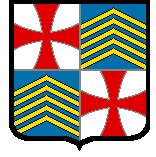
Previous Master : Renaud de Vichiers - Next Master : Guillaume de Beaujeu
 Guillaume de Beaujeu (1233??-1291) Guillaume de Beaujeu (1233??-1291)
Master of the Temple from 1273 to 1291.
Guillaume de Beaujeu is elected at the head of the Order on May 13th 1273.
Entered in the Order from the age of 20, he is successively Preceptor of the Province of Tripoli in 1271, preceptor of the Province of Pouilles in 1272 before being elected.
He came from a powerful family of Beaujolais and had family ties with king of France Louis IX and Charles of Anjou, king of Sicily.
As soon he is elected, Guillaume de Beaujeu undertakes to visit the main preceptories in the Occident and is convened by Pope Gregory X to the Council of Lyon during the summer of 1274. The pope seeks opinions of both of the Master of the Templars and of the Hospitaliers to organise a new crusade. Occidental barons aren’t very enthusiastic about the idea of a new expedition to the Holy Lands. The death of the pope in 1276 definitively interrupts the preparations for this expedition.
Despite of repeated calls from the Templars of the Orient, Guillaume de Beaujeu only arrives in Acre in September 1275.
In 1279, he enters into conflict with Hugh III King of Cyprus, who has the Templar properties on the Island confiscated. This crisis will last more than 20 years, and only with the Master Jacques de Molay will it find the beginnings of resolution.
In 1282, Guillaume de Beaujeu, whose politics toward the Muslims was to gain time, profited of the Mongol Invasion in the East and in the North to extend for ten years the truce signed in 1271 with Baybars.
The Frankish politics are however divided on the relationship with the Mongols and the Muslims. On one side, Armenian Christians seek an alliance with the Tartar hordes and on the other side, Christians from south prefer to stay neutral.
Guillaume de Beaujeu, on the other hand, maintains friendly relationships with Cairo.
In 1288, Kalâwun, the successor of Baybars, decides in spite of the truce to attack Tripoli.
Guillaume de Beaujeu, thanks to close relations he holds with the Sultan of Cairo’s court, gets wind of the impending preparations, and warns the dignitaries of the city, who don’t believe him because they think that they are protected by the truce. On the contrary, they think that the Master of the Templars want them to flee, because he may easily seize the city to transform it into a Templar site.
Despite warnings from Guillaume de Beaujeu, the city falls into muslim hands on April 26th 1289.
Not satisfied with the fall of Tripoli, Kalawun initiates at the end of 1289 the preparations to besiege the city of Acre.
The slaughter of Muslim merchants on the road to Acre by recently disembarked Lombard troops gives him a justification he doesn’t really need. In order to hide his preparations, Kalawun requires that those responsible for the slaughter be surrendered to him under penalty of awful reprisals.
Guillaume de Beaujeu proposes to the dignitaries of Acre to empty the prisons of thise condemned to die and deliver them to Kalâwun to save time.
The notables reject the decision of the Master of the Order of the Temple and remain deaf at the requests of Kalâwun, thinking them also of being protected by the truce concluded in 1282.
The Christians benefit nevertheless from a few weeks of respite with the death of Kalâwun in November 1290 in Cairo.
A civil war starts for the succession of the emir, but Al-Ashraf Khalil the son of the latter, manages to thwart the plot and orders the execution of the General Turuntaî, head of the rebels.
Only in April 1291 does Al-Ashraf Khalil arrive with his army, estimated by the chroniclers of the time at 200 000 men, in front of the walls of the city.
On April 05th, the city is completely encircled, and the Muslim machines of war are installed.
Templars and Hospitalers ordered by their Masters, Guillaume de Beaujeu and Jean de Villiers, forget all their dissensions and organize the defence of the northern part of the ramparts of the city, while Konrad von Feutchwangen, Master of the Teutonic Order and Amaury, the brother of king of Cyprus Henry II ordering the Syrian and Cypriot knighthood, deal with the Western part of the ramparts.
The night of the 15 to April 16, Guillaume de Beaujeu tries an exit with 300 knights. He surprises a contingent which camps opposite his positions, massacres several hundreds of combatants, but must retreat to the shelter of the ramparts of the city before being able to destroy all the war machinery located in the enemy camp.
On May 16, in spite of the arrival a few days before of king of Cyprus Henri II and of a thousand of combatants, part of the wall breaks down under as a result of the enemy sappers. The Muslims enter the breach, but the combined attacks of the three Orders prevents them from progressing further into the city, and the defenders even manage to repel the Muslims beyond the ramparts.
On May 18, Al-Ashraf Khalil launches the final attack, thousands of Muslim infantrymen arrive in front of the breach in the wall and launch the attack of the towers and the remaining walls.
Guillaume de Beaujeu gathers ten knights and as many Hospitalers including their Master, and launches into the terrible murderous storm.
With his twenty-odd knights, Guillaume de Beaujeu manages to temporarily stem the enemy flood that spread into the city. Just as he manages to push back the enemies who had seized the door of Saint-Antoine, he is mortally wounded. The arrival of several contingents of reinforcement enables him to regain the templar fortress located at the south of the city and he dies there.
The city falls into the hands of Muslims a few days later, in spite of the heroic defence of the Templars who will fight until the last, cut off in their strengthened bastion, in the south of the city. This keen defence allows nevertheless a good many inhabitants of the city and several knights to leave Acre safely and to take refuge in Cyprus.
Thibaud Gaudin and Pierre de Sevry, the highest two dignitaries still alive in Acre decide to separate. Thibaut Gaudin, commander of Acre, retreats to the sea towards Sidon still in Christian hands, while Pierre de Sevry, Marshall of the Order, continue to resist the Muslims tidal wave.
Pierre de Sevry succeeds in maintaining thousands of Muslims combatants with only a handful of defenders. The city capitulates finally on May 28, after the Templar bouse collapses on tens of defenders and over 2000 Turks who attack it.
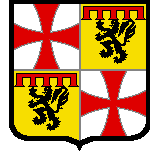
Previous Master : Thomas Béraud - Next Master : Thibaud Gaudin
 Thibaud Gaudin (12??-1292) Thibaud Gaudin (12??-1292)
Master of the Order from 1291 to 1292.
The origin of Thibaud Gaudin within the Order is rather mysterious. He originated from a noble family of the area of Chartres or Blois, and entered the Order well before 1260. We know this because on that date he was captured during a raid on Tibériade. We also know his great piety earned him the nickname "Monk Gaudin".
In 1279, Gaudin occupied the position of "Preceptor of the Land of Jerusalem", the fourth most significant position in the Templar hierarchy. In 1291, he was at the side of Guillaume de Beaujeu defending the town of Acre as it was besieged by the formidable Al-Ashraf Khalil army.
On May 18th of the same year, upon the death of Guillaume de Beaujeu, a mere handful of the 500 strong Templar garrison remained in Acre. Thibaut Gaudin and Pierre de Sevry, Marshal of the Order, were the last two dignitaries of the Temple to defend Acre.
Al-Ashraf Khalil sent messengers to the Templar defenders in order to negotiate an honourable surrender. Thibaut Gaudin and Pierre de Sevry agreed to yield under the conditions dictated by the sultan, which included allowing a detachment of Muslims riders into their enclosure.
As soon as the Muslim detachment entered they began to attack the Frankish women. Considering this a betrayal of the agreement, Thibaut Gaudin and Pierre de Sevry ordered the garrison to drive out the Muslims and to secure themselves behind barricades.
The two dignitaries decided that Thibaut Gaudin would exit the city by sea and carry with him the treasure of the Temple. Pierre de Sevry continued the combat, but Acre fell the following day.
Thibaut Gaudin, accompanied by some knights, arrived at Sidon where he was elected Master. He decided to defend the city and his insular castle for as long as possible. Just before the arrival of emir Al-Shujâ'i, the inhabitants evacuated the city and took refuge behind the walls of the Templar stronghold.
Some time later, and with the assistance of Cypriot, the majority of the inhabitants and garrison evacuated the fortress to take refuge in Cyprus. The reinforcements that Thibaut Gaudin tried to gather on his arrival at Cyprus never arrived in the Holy Land. Sidon fell into Muslims hands on July 14th, 1291.
The last Frankish occupations in the Kingdom of Jerusalem fell one after the other. Beirut was taken on July 21st. The area of Caïffa was invaded and the monasteries of Mount Carmel were destroyed on July 30th. At the beginning of August, the Franks had nothing except two fortified towns, occupied by the Templars, Tortose, and Chateau-Pelerin. The first town was evacuated on August 3rd and the second on August 14th.
All Templars retreated to Cyprus and the islet of Ruad, on the south of Tortose. The latter remained in their hands until 1303.
In October 1291, a general chapter of the Order met in Cyprus. This chapter confirmed the election of Thibaut Gaudin as Master. It also appointed new dignitaries to significant positions within the hierarchy of the Order. On this occasion, Jacques de Molay was named Marshal to succeed Pierre de Sevry, who died under the walls of Acre.
Due to the large number of deaths within the upper ranks of the Templars, one mission for Thibaud Gaudin was to rebuild the organisation.
While doing so, Gaudin also found it necessary to defend the Kingdom of Little Armenia, encircled by Seldjoukides, and the island of Cyprus, occupied by a multitude of refugees.
At the beginning of 1292 Thibaut Gaudin died of exhaustion. However, he left behind an enormous building site for his successor.

Previous Master : Guillaume de Beaujeu - Next Master : Jacques de Molay
 Jacques de Molay (1244??-1314) Jacques de Molay (1244??-1314)
Master of the Order from 1292 to 1312.
The absence of correct archives prevents the exact establishment of the places and date of birth of Jacques de Molay. Nevertheless, indications found in the minutes of the lawsuit, in the archives of European kingdoms of that time, suggest that Jacques de Molay was born about 1245 in the French region of Haute-Saône, in the County of Burgundy, always vassal to the Germanic Empire.
In 1265 ,he is received in the Order at the city of Beaune by Humbert de Pairaud, visitor of France and England and by Amaury de la Roche, Master of France.
Around 1270, he is in the Orient where his activity remains very discrete. It is not known if he is among the survivors of Acre who managed to escape with Thibaud Gaudin to Cyprus, but he participates a chapter which is held in the island in autumn 1291. He is elected Master of the Order before April 1292, shortly after the death of Thibaud Gaudin.
No sooner was elected that Jacques de Molay attends to the most pressing issues, to set up both the government and the defences of the island of Cyprus and the Kingdom of Little Armenia, the last Frankish possessions in the East.
In the spring of 1293, he undertakes a long trip to Europe, where he settles various issues in the realm of the Order, and in particular seeks help from the Western princes and the Church to protect the last Christian States.
During this trip, he forges close ties with several monarchs, among them Edward 1st of England, Jacques II of Aragon and the pope Boniface VIII.
He returns to Cyprus in the fall of 1296 to settle issues that had arisen with the king Henri II.
In 1298, he organises a raid in Cilicia after the fall of Roche-Guillaume, the last fortified town of the kingdom. Unfortunately, the Christian force were unable to benefit from the victory of Ghâzân, Khan of Persia, over the Mameluks at the Homs in December 1299.
In 1300, he continues to reinforce the small island of Ruad opposite Tortose to make it a base of advanced operations together with the Mongols. But they too, preoccupied with their own tribal wars, will never be able to combine with the Christians against the Mameluks.
In September 1302, the Templars of Ruad are massacred by the Egyptian Mameluks.
Jacques de Molay then gives up this strategy of the Mongolian alliance which proves to be a total failure.
In 1305, the new pope Clement V, seeks the opinion of the Masters of the religious Orders in preparation for a new crusade and the unification of the Orders.
On June 6, 1306, Clement V officially convenes them in Poitiers, but because of the pope's ill health, he only meets Jacques de Molay in May 1307.
As he had told the pope before, Jacques de Molay categorically rejects the prospect of uniting the Orders.
This stance will have serious repercussions for the future Order of the Temple. At first, the King of France takes umbrage to this decision, because it interferes not only with his ambitions but also wth the negotiations between Clement V and Philippe IV to condemn the memory of Boniface VIII, and also in organizing new crusades.
On his trip west, Jacques de Molay finds that libellous rumours were spread about the Templars. Philippe IV and his advisers immediately take advantage of this weakness, and set a plan to destroy this uncompromising Order.
On June 24, Jacques de Molay is in Paris to meet with the King of France and discuss the charges against the Order. He returns to Poitiers, reassured by his interview with Philippe IV, but requests of the Pope an investigation to clear Order of any suspicion.
On August 24, Clement V informs Jacques de Molay of a board of inquiry. Philippe IV seeks to precipitate events and remove them from the Pope’s control. On September 14, with the help of Nogaret, he orders in utter secrecy all his bailiffs and seneschals to arrest all Templars of the Kingdom and the confiscation of all their goods.
This wide-ranging operation begins on October 13, 1307 at dawn. All Templars of the kingdom of France are arrested. In some preceptories, Templars are massacred by treachery, because the royal men-at-arms are afraid to face these fierce warriors in direct combat.
Jacques de Molay is arrested in the headquarters of the Order, in Paris.
Something strange occured during the first interrogation of Jacques de Molay on October 24. Instead of denying the charges, he confesses to certain facts, thus giving credence to royal propaganda against the Order.
In December 1307, Clement V sends cardinals in Paris to question the Master of the Order. In front of those, This puts Philippe IV and Clement V at loggerheads, and is only resolved in August 1308 through a compromise sealed by the papal bull "Faciens Misericordiam". In this bull, the pope reserves the right to judge the dignitaries of the Order.
Transferred to Chinon with several other dignitaries of the Order, like Geoffroy de Charney, Hugues de Pairaud and Geoffroy de Gonneville, Jacques de Molay is now interrogated by royal agents. During this interrogation, he will renew his admissions made in October 1307.
Over more than a year, the pontifical commission is set up and begins audiences. Jacques de Molay will be able to make depositions there only twice towards the end of November 1309. On this occasion, he changes his defence strategy, stays silence and relies solely on the judgement from the pope, trusting the contents of the bull "Faciens Misericordiam".
In 1310, several tens of Templars seek to testify before the pontifical commission in favour of the Order and thus cast in doubt the entire indictment.
This protest movement is utterly broken by the sentencing to be burnt at the stake of 54 Templars, judged to have recanted by Philippe de Marigny on May 10, 1310.
Moreover, the leaders of this protest movement disappear without traces from the jails of Philippe IV.
On March 22, 1312, Clement V announces the official abolition of the Order of the Temple at the Council of Vienna.
In spite of his strong will and insistent demands toward his jailers, Jacques de Molay lingers in prison without audience from the pope. The latter nevertheless agrees to send three cardinals to Paris in December 1313 to decide on the fate of the dignitaries.
Arriving in Paris in March 1314, the three cardinals dispense an irrevocable verdict, to condemn the dignitaries of the Order to life imprisonment.
Jacques de Molay and Geoffroy de Charnay hotly contest this verdict, understanding that they had been played since the beginning by a Pope who did not want to hear them. They both revoke all admissions made and proclaim the Order innocent of any charge carried against it.
Jacques de Molay and Geoffroy de Charnay are immediately charged of recanting, and are delivered by the Cardinals to the secular law. A pyre is build the very same day on an island (Île de la Cité) of the Seine, at the foot of Notre-Dame Cathedral.
In the evening of March 11, 1314, (or March 18 according to some historians) Jacques de Molay and Geoffroy de Charnay are set alight.

Previous Master : Thibaud Gaudin
|


 The dignitaries of the Templar Order
The dignitaries of the Templar Order






